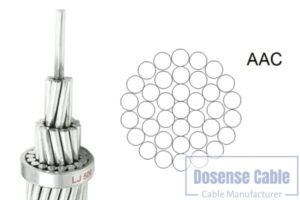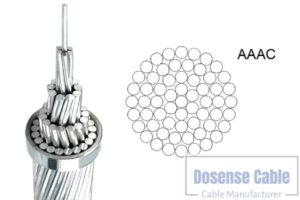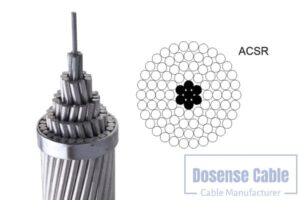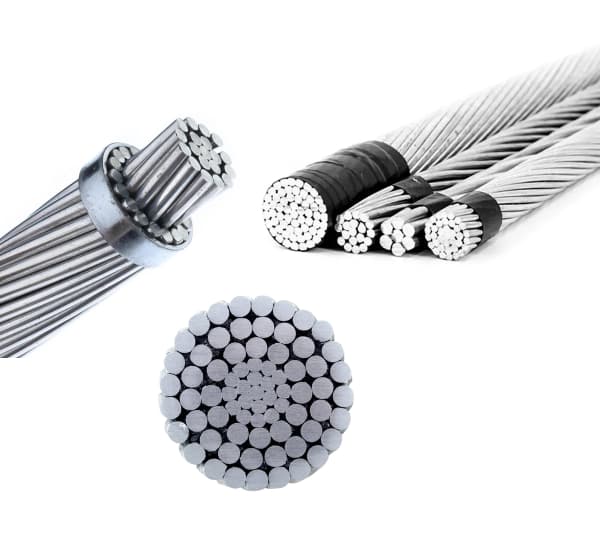AAC Bare Aluminum Conductor, AAAC, ACSR
Bare wire is an economical and durable option for installing outdoor electrical systems
AAC Bare Aluminum Conductor,AAAC,ACSR.
AAC (All Aluminum Conductor) is an all-aluminum conductor suitable for light applications.
ACSR (Aluminium Core Steel Reinforced) It is a conductor with a central steel core for greater strength.
AAAC (All Aluminum Alloy Conductor) It is an all-aluminum alloy conductor with higher corrosion resistance and strength.
Conductor choice depends on specific transmission line requirements and environmental conditions.
Bare Aluminum Conductor is one of our main products in Dosense Cable
AAC Bare Aluminum Conductor,AAAC,ACSR
AAC - All Aluminum Conductor

Composition: AAC is made of braided aluminum wires.
Utilization: Typically used in overhead power transmission lines where a lightweight conductor with good conductivity is required..
Advantages: Light, corrosion resistant and economical.
Estandard:
ASTM-B 230、ASTM-B 231、TS IEC 1089、FROM 48201、BS 215.
AAAC - All Aluminum Alloy Conductor

Composition: AAAC is made of braided aluminum alloy wires.
Purpose: AAAC is used in overhead power transmission lines where high corrosion resistance and good conductivity are essential.
Advantages: Offers greater corrosion resistance than AAC due to its aluminum alloy composition. It is also very resistant and light.
Estandard :
ASTM-B 230、ASTM-B 231、TS IEC 1089、DIN48201、BS 215.
ACSR - Aluminum Core Steel Reinforced Conductor Cable

Composition: ACSR is composed of a central core of steel wires surrounded by aluminum filaments.
Utilization: Widely used in medium and high voltage overhead power lines. Steel core provides strength, while aluminum filaments offer conductivity.
Advantages: Combines the resistance of steel with the conductivity of aluminum, making it suitable for large spans and high voltage applications.
Cable ACSR, It is one of Aluminum Cable,It is a common option in electric transmission systems. The ACSR cable combines aluminum and steel strands, offering resistance and conductivity. This type of aluminum cable is used in high tension lines due to its efficiency and durability.. Its design allows efficient transmission of electrical energy, adapting to various environmental conditions.
Estandard :
ASTM-B 230、ASTM-B 231、TS IEC 1089、DIN48201、BS 215.
How to choose between AAC bare aluminum conductor, AAAC y ACSR?
Bare aluminum cable is used in high voltage electrical networks to transmit energy efficiently and safely..
AAC, AAAC and ACSR are used in electrical and power transmission installations.
AAC (aluminum conductor): AAC is all aluminum conductor. Commonly used in low and medium voltage power lines. It is also lightweight, Corrosion resistant and easy to handle and install.
AAC cables are suitable for applications where conductivity and corrosion resistance.
AAAC (All aluminum alloy driver): AAAC is an aluminum alloy conductor. This alloy provides greater mechanical resistance and better conductivity than AAC.. It is suitable for high voltage power transmission applications and corrosion resistance.
AAAC is lighter than ACSR, but it has a higher current capacity compared to AAC.
ACSR (aluminum conductor, reinforced with steel): ACSR is an aluminum conductor, reinforced with steel. improves both mechanical resistance and electrical conduction capacity.
Commonly used in high voltage and long distance transmission lines. Core steel provides tensile strength, while aluminum provides the electrical conductivity.
ACSR is heavier than AAC and AAAC but has a higher load capacity and is more suitable for long distances.
In summary, the choice between AAC, AAAC and ACSR depends on factors such as the specific application, transmission distance, the required load capacity and environmental conditions. It is important to consult an electrical engineering expert to determine the appropriate type of cable for each situation..
How to design bare aluminum AAC conductor, AAAC y ACSR?
The AAC design, AAAC and ACSR has several factors, as the current capacity, mechanical resistance, corrosion resistance and specific application.
AAC (aluminum conductor): Appropriate AAC diameter and cross section of aluminum conductor to meet mechanical and current strength requirements.
AAAC (All aluminum alloy driver): AAAC design factors have the density, resistivity and tensile strength of the aluminum alloys used.
Besides, AAAC power losses and load capacity must be calculated to ensure adequate performance in the intended application.
ACSR (aluminum conductor, reinforced with steel): ACSR design factors have tensile strength, electrical conductivity and charging capacity, environmental conditions.
Besides, Resistance power losses and voltage drop must be calculated to ensure efficient and reliable performance of the ACSR on the transmission line.
In all cases, It is important to perform detailed calculations and consider relevant standards and regulations to ensure the safety and efficiency of the power cable design..

